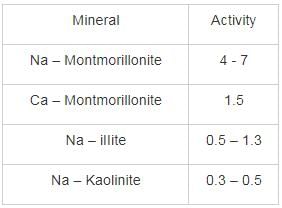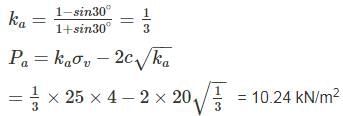All Exams >
Civil Engineering (CE) >
RRB JE for Civil Engineering >
All Questions
All questions of Soil Mechanics for Civil Engineering (CE) Exam
A fully saturated clay has a water content of 40% and unit weight 19 kN/m3. After oven drying the dry density of the soil becomes 18 kN/m3. The shrinkage limit for the soil sample is ______%. (Take γw=γw=10 kN/m3)
Correct answer is between '21,23'. Can you explain this answer?
A fully saturated clay has a water content of 40% and unit weight 19 kN/m3. After oven drying the dry density of the soil becomes 18 kN/m3. The shrinkage limit for the soil sample is ______%. (Take γw=γw=10 kN/m3)

|
Raghavendra Sengupta answered |

And, e sr = wG
⇒ e × 1 = 0.40 G

⇒ G = 2.97
Shrinkage limit, ws =
Where, Gm = Mass specific gravity at dry state


⇒ G = 2.97
Shrinkage limit, ws =

Where, Gm = Mass specific gravity at dry state

If the plasticity index of a soil is 45%, then the soil will be:- a)non-plastic
- b)very highly plastic
- c)low plastic
- d)medium plastic
Correct answer is option 'B'. Can you explain this answer?
If the plasticity index of a soil is 45%, then the soil will be:
a)
non-plastic
b)
very highly plastic
c)
low plastic
d)
medium plastic

|
Aditi Sarkar answered |

Plasticity index (PI) is the range of water content over which the soil remains in the plastic state. Mathematically defined as,
Plasticity Index = Liquid Limit (w
L
) - Plastic Limit (wp
)
A fully saturate capillary zone of thickness 2 m exists above the water table in a fine silty sand deposit. Water is the pore water pressure at 1.5 m above the water table?- a)5 kN/m2
- b)-15 kN/m2
- c)-5 kN/m2
- d)15 kN/m2
Correct answer is option 'B'. Can you explain this answer?
A fully saturate capillary zone of thickness 2 m exists above the water table in a fine silty sand deposit. Water is the pore water pressure at 1.5 m above the water table?
a)
5 kN/m2
b)
-15 kN/m2
c)
-5 kN/m2
d)
15 kN/m2

|
Sahil Mehra answered |
Above the water table pore pressure will be negative
Pore pressure at 1.5 m above the WT
= - γwz = - 10 × 1.5 = -15 kN/m2.
Assuming that a river bed level does not change and the depth of water in the river was 10m, 15m, and 8m during the months of February, July and December respectively of a particular year. The average bulk density of the soil is 20 kN/m3. The density of water is 10 kN/m3. The effective stress at a depth of 10 m below the river bed during these months would be- a)300 kN/m2, in February, 350 kN/m2 in July and 320 kN/m2 in December
- b)100 kN/m2 in February, 100 kN/m2 in July and 100 kN/m2 in December
- c)200 kN/m2 in February, 250 kN/m2 in July and 180 kN/m2 in December
- d)300 kN/m2 in February, 350 kN/m2 in July and 280 kN/m2 in December
Correct answer is option 'B'. Can you explain this answer?
Assuming that a river bed level does not change and the depth of water in the river was 10m, 15m, and 8m during the months of February, July and December respectively of a particular year. The average bulk density of the soil is 20 kN/m3. The density of water is 10 kN/m3. The effective stress at a depth of 10 m below the river bed during these months would be
a)
300 kN/m2, in February, 350 kN/m2 in July and 320 kN/m2 in December
b)
100 kN/m2 in February, 100 kN/m2 in July and 100 kN/m2 in December
c)
200 kN/m2 in February, 250 kN/m2 in July and 180 kN/m2 in December
d)
300 kN/m2 in February, 350 kN/m2 in July and 280 kN/m2 in December

|
Ishita Patel answered |
Since the river bed level does not change and the depth of water is changing only above the river bed, the effective stress below the river bed will not change.
Total stress at a depth of 10 m below river bed.
σ = 20 × 10 = 200 kN/m2
Pore water pressure,
u = 10 × 10 = 100 kN/m2
∴ Effective stress,

= 100 kN/m2
Thus effective stress will be 100 kN/m2 each on the month of February, July and December.
The soil has to be excavated from a borrow-pit which has a density of 1.12 gm/cc with a water content of 12% to fill a land. The soil is compacted to a density of 1.32 gm/cc with water content 20%. Find the volume of soil to be excavated in m3 for 1000 m3 volume of the fill?
Correct answer is between '1070,1130'. Can you explain this answer?
The soil has to be excavated from a borrow-pit which has a density of 1.12 gm/cc with a water content of 12% to fill a land. The soil is compacted to a density of 1.32 gm/cc with water content 20%. Find the volume of soil to be excavated in m3 for 1000 m3 volume of the fill?

|
Nishanth Banerjee answered |

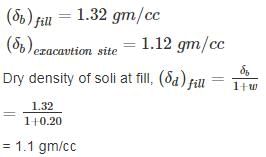
Dry density of soil at excavation site,
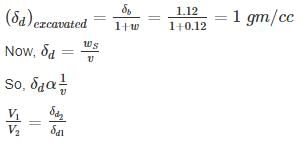
∴ Volume of excavated soil =

= 1000 × 1.1/1
= 1100 m3
A soil sample is tested in a consolidometer shows compression of 0.75 mm when the load is increased from 50 kN/m2 to 100 kN/m2. If instead of 100 kN/m2, the load is increased to 150 kN/m2, settlement of the soil sample will be _____ mm.
Correct answer is between '1.1,1.2'. Can you explain this answer?
A soil sample is tested in a consolidometer shows compression of 0.75 mm when the load is increased from 50 kN/m2 to 100 kN/m2. If instead of 100 kN/m2, the load is increased to 150 kN/m2, settlement of the soil sample will be _____ mm.

|
Shreya Choudhary answered |
Consolidation settlement is given by:

Where,
CC = Compression index
e0 = Initial void ratio of the soil sample
H0 = Thickness of the soil sample
σ̅0 = Initial effective stress at the centre of the soil sample
 Increase in effective stress at the centre of the soil sample
Increase in effective stress at the centre of the soil sample
 Increase in effective stress at the centre of the soil sample
Increase in effective stress at the centre of the soil sampleCalculation:
ΔH1 = 0.75 mm
σ̅0 = 50 kN/m2

ΔH2 = 1.188 mm

ΔH2 = 1.188 mm
A commercial building circular in the plan is situated at a particular site. If the total load from the building including its self-weight is 150 kN/m2, determine the vertical stress (kN/m2) at a depth of 8 m below the C.G of the load area. Assume the diameter of the building to be 3 m.
Correct answer is between '7.3,7.7'. Can you explain this answer?
A commercial building circular in the plan is situated at a particular site. If the total load from the building including its self-weight is 150 kN/m2, determine the vertical stress (kN/m2) at a depth of 8 m below the C.G of the load area. Assume the diameter of the building to be 3 m.

|
Saptarshi Nair answered |
Concept:
Vertical pressure below uniformly loaded circular area is given by:
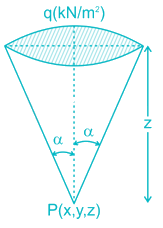
σz = kq
where,
k = 1 – cos3 ∝
cos∝= 

Calculation:
q = 150 kN/m2
z = 8 m
r = 3/2m = 1.5m
cos∝ = 

cos ∝ = 0.983
k = 1 – cos3 ∝ = 1 – (0.983)3
k = 0.050
σz = 0.050 × (150)
σz = 7.5 kN/m2
A 4m × 3m raft is provided at a depth of 3 m below the ground surface in a purely cohesive soil such that the ultimate bearing capacity by Terzaghi’s is given by 1450kN/m2. The net ultimate bearing capacity by Skempton is _______kN/m2.Assume Bearing capacity factor by Terzaghi to be: NC = 5.7, Nq = 1.0. Unit weight of clay layer to be 19 kN/m3
Correct answer is between '1375,1377'. Can you explain this answer?
A 4m × 3m raft is provided at a depth of 3 m below the ground surface in a purely cohesive soil such that the ultimate bearing capacity by Terzaghi’s is given by 1450kN/m2. The net ultimate bearing capacity by Skempton is _______kN/m2.
Assume Bearing capacity factor by Terzaghi to be: NC = 5.7, Nq = 1.0. Unit weight of clay layer to be 19 kN/m3

|
Shreya Choudhary answered |
A 4m is a unit of measurement that refers to a length of 4 meters. It is commonly used to measure distances or lengths in various contexts, such as in construction, athletics, or everyday objects.
Piping in soil occurs when:- a)The soil is highly porous
- b)Sudden change in permeability occurs
- c)Effective pressure becomes zero
- d)The soil is highly stratified
Correct answer is option 'C'. Can you explain this answer?
Piping in soil occurs when:
a)
The soil is highly porous
b)
Sudden change in permeability occurs
c)
Effective pressure becomes zero
d)
The soil is highly stratified

|
Sahil Chawla answered |
The design of an embankment dam and other hydraulic structures, the choice of soils are aimed at reducing or eliminating the detrimental effects of seeping water. Where high hydraulic gradients exist there is a possibility that the seeping water may cause internal erosion within the dam, especially if the soil is poorly compacted. Erosion can work its way back into the embankment, creating voids in the form of channels or ‘pipes’, and thus impairing the stability of the dam. This form of erosion is referred to as piping and occurs when water flow upwards resulting in zero effective pressure.
Calculate the saturated unit weight (kN/m3) of the soil sample for the Quick sand condition, if specify Gravity and void ratio of soil sample is 2.62 and 0.61 respectively. Take γW = 10 kN/m3
Correct answer is between '20.05,20.07'. Can you explain this answer?
Calculate the saturated unit weight (kN/m3) of the soil sample for the Quick sand condition, if specify Gravity and void ratio of soil sample is 2.62 and 0.61 respectively. Take γW = 10 kN/m3

|
Anuj Verma answered |
For a Quicksand Condition
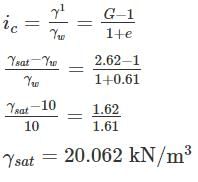

In wet soil mass, air occupies one-sixth of its volume and water occupies one – third of its volume. The void ratio of the soil is- a)0.25
- b)0.5
- c)1.00
- d)1.50
Correct answer is option 'C'. Can you explain this answer?
In wet soil mass, air occupies one-sixth of its volume and water occupies one – third of its volume. The void ratio of the soil is
a)
0.25
b)
0.5
c)
1.00
d)
1.50

|
Tanishq Rane answered |
Void ratio, e = Vv/Vs
Vv = air void + water filled voids
Calculation:
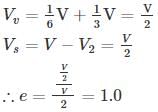
Calculation:

A 50 cm well completely penetrates an artesian aquifer. The length of the strainer is 25m. Determine the discharge (in lph) from the well, when the drawdown in the pumping well is 4 m. The K of the aquifer is 45 m/day. At a radial distance of 400 m from center of well, drawdown is zero.
Correct answer is between '159680,159685'. Can you explain this answer?
A 50 cm well completely penetrates an artesian aquifer. The length of the strainer is 25m. Determine the discharge (in lph) from the well, when the drawdown in the pumping well is 4 m. The K of the aquifer is 45 m/day. At a radial distance of 400 m from center of well, drawdown is zero.

|
Ishani Basu answered |
Given data:
- Diameter of well (D) = 50 cm
- Length of strainer (L) = 25 m
- Drawdown in pumping well (s) = 4 m
- Hydraulic conductivity (K) = 45 m/day
- Radial distance from center of well (r) = 400 m
- Drawdown at r = 0
Calculations:
1. Calculate the transmissivity (T) of the aquifer using the formula:
T = K * L
T = 45 m/day * 25 m = 1125 m²/day
2. Calculate the discharge (Q) from the well using the Theis equation:
Q = 2πT(s - s0) / ln(r / rw)
Q = 2π * 1125 * (4 - 0) / ln(400 / 0.5)
Q ≈ 159683 lph
Therefore, the discharge from the well when the drawdown in the pumping well is 4 m is approximately 159683 lph, which falls within the range provided (159680-159685).
- Diameter of well (D) = 50 cm
- Length of strainer (L) = 25 m
- Drawdown in pumping well (s) = 4 m
- Hydraulic conductivity (K) = 45 m/day
- Radial distance from center of well (r) = 400 m
- Drawdown at r = 0
Calculations:
1. Calculate the transmissivity (T) of the aquifer using the formula:
T = K * L
T = 45 m/day * 25 m = 1125 m²/day
2. Calculate the discharge (Q) from the well using the Theis equation:
Q = 2πT(s - s0) / ln(r / rw)
Q = 2π * 1125 * (4 - 0) / ln(400 / 0.5)
Q ≈ 159683 lph
Therefore, the discharge from the well when the drawdown in the pumping well is 4 m is approximately 159683 lph, which falls within the range provided (159680-159685).
Match List – I (Type of soil) with List-II (Mode of transportation and deposition) and select the correct answer using the codes given below the lists:
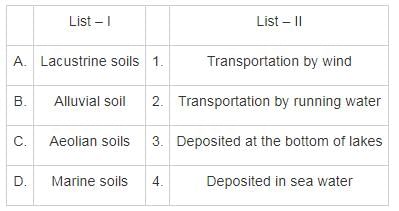
- a)A - 1 B - 2 C - 3 D - 4
- b)A - 3 B - 2 C - 1 D - 4
- c)A - 3 B - 2 C - 4 D - 1
- d)A - 1 B - 3 C - 2 D - 4
Correct answer is option 'B'. Can you explain this answer?
Match List – I (Type of soil) with List-II (Mode of transportation and deposition) and select the correct answer using the codes given below the lists:


a)
A - 1 B - 2 C - 3 D - 4
b)
A - 3 B - 2 C - 1 D - 4
c)
A - 3 B - 2 C - 4 D - 1
d)
A - 1 B - 3 C - 2 D - 4

|
Pari Maharana answered |
B
Consider the following statementsP. For a given compactive effort, the permeability decreases sharply with the increase in water content on the dry side of optimum.Q. For a given compactive effort, the soil tends to have a dispersed structure on the dry of optimumR. For a given compactive effort, the soil tends to have a flocculated structure on the wet of optimumS. Soils compacted on the dry of optimum tend to exhibit more shrinkage upon drying than those compacted wet of optimum
- a)P - True Q - False R - False S - True
- b)P - False Q - True R - True S - False
- c)P - True Q - False R - False S - False
- d)P - False Q - True R - True S - True
Correct answer is option 'C'. Can you explain this answer?
Consider the following statements
P. For a given compactive effort, the permeability decreases sharply with the increase in water content on the dry side of optimum.
Q. For a given compactive effort, the soil tends to have a dispersed structure on the dry of optimum
R. For a given compactive effort, the soil tends to have a flocculated structure on the wet of optimum
S. Soils compacted on the dry of optimum tend to exhibit more shrinkage upon drying than those compacted wet of optimum
a)
P - True Q - False R - False S - True
b)
P - False Q - True R - True S - False
c)
P - True Q - False R - False S - False
d)
P - False Q - True R - True S - True

|
Rutuja Deshpande answered |
Effect of compaction on structure


At point 1:

Flocculent structure is found on dry side of optimum and with increase in water content of soil there will be decrease in permeability of the soil due to improved orientation of the particles which results in a decrease in the size of voids.
At point 3:

At same compactive effort dispersed structure is found on wet side of optimum
Effect of shrinkage: Due to random orientation of the soil particles and stronger inter-particle bonds, shrinkage on dry of optimum side is found to be less than shrinkage on wet of optimum side.
Compactive effort: With increase in comp active effort at same water content the soil tend to become more oriented (dispersed) especially on the dry side of optimum.
Point 5:


A series of wells were dug in a confined aquifer. The surface obtained by connecting the static water levels would be called:- a)Piezometric surface
- b)Phreatic line
- c)Cone of depression
- d)Perched water table
Correct answer is option 'A'. Can you explain this answer?
A series of wells were dug in a confined aquifer. The surface obtained by connecting the static water levels would be called:
a)
Piezometric surface
b)
Phreatic line
c)
Cone of depression
d)
Perched water table

|
Anmol Roy answered |
Confined aquifers are permeable rock units that are usually deeper under the ground than unconfined aquifers. They are overlain by relatively impermeable rock or clay that limits groundwater movement into, or out of, the confined aquifer. Groundwater in a confined aquifer is under pressure and will rise up inside a borehole drilled into the aquifer. The level to which the water rises is called the piezometric surface.
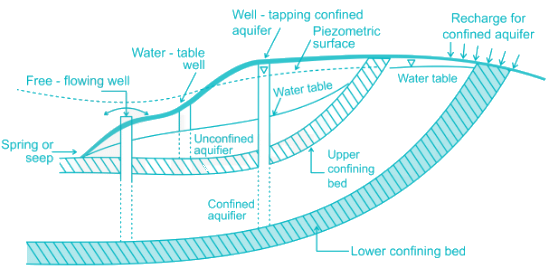

Which of the following assumptions is wrongly stated in regard to Rankine’s theory of earth pressure?- a)The back of the wall is not smooth.
- b)The ground surface is plane.
- c)The soil mass is semi-infinite and homogeneous.
- d)The retaining wall yields about the base.
Correct answer is option 'A'. Can you explain this answer?
Which of the following assumptions is wrongly stated in regard to Rankine’s theory of earth pressure?
a)
The back of the wall is not smooth.
b)
The ground surface is plane.
c)
The soil mass is semi-infinite and homogeneous.
d)
The retaining wall yields about the base.

|
Yashvi Choudhury answered |
The Rankine's theory assumes that there is no wall friction, the ground and failure surfaces are straight planes, and that the resultant force acts parallel to the backfill slope.
The soil mass is homogeneous and semi-infinite and retaining wall yields about the base.
In case of retaining structures, the earth retained may be filled up earth or natural soil. These backfill materials may exert certain lateral pressure on the wall.
The water content of a soil sample is found to be 35%. If the percentage of air voids present in the soil sample is 5%. Then compute dry unit weight and air content of the soil sample when the void ratio of the soil sample is 0.65.Take specific gravity of soil solids and unit weight of water to be 2.70 and 10 kN/m3.- a)22.09 kN/m3 and 5%
- b)13.19 kN/m3 and 12.70%
- c)13.19 kN/m3 and 20%
- d)22.09 kN/m3 and 10%
Correct answer is option 'B'. Can you explain this answer?
The water content of a soil sample is found to be 35%. If the percentage of air voids present in the soil sample is 5%. Then compute dry unit weight and air content of the soil sample when the void ratio of the soil sample is 0.65.
Take specific gravity of soil solids and unit weight of water to be 2.70 and 10 kN/m3.
a)
22.09 kN/m3 and 5%
b)
13.19 kN/m3 and 12.70%
c)
13.19 kN/m3 and 20%
d)
22.09 kN/m3 and 10%

|
Devika Tiwari answered |
Dry unit weight is given by

ηa = 0.05
G = 2.70
ω = 0.35


ηd = 13.19 kN/m3
ηa = acη
η → porosity
ac → aircontent

ac = 0.1269
ac = 12.70%

ac = 0.1269
ac = 12.70%
Previous sand having air content 15% is used in the foundation of a masonry dam. If the maximum permissible upward gradient for a factor of safety of 3 against boiling is 0.315. The percentage of air voids in the previous sand will be ______ %.
Correct answer is between '6.2,6.6'. Can you explain this answer?
Previous sand having air content 15% is used in the foundation of a masonry dam. If the maximum permissible upward gradient for a factor of safety of 3 against boiling is 0.315. The percentage of air voids in the previous sand will be ______ %.

|
Manasa Sen answered |
F.O.S against boiling is giving by
F.O.S = 

ier = critical hydraulic gradient
iper = permissible hydraulic gradient


η = percentage air voids
ac = air content
η = porosity
calculation:
icr = iper x FOS
icr = 0.315 × 3
icr = 0.945
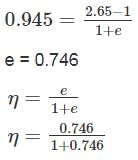

η = 0.427 = 42.7%
ac = 15%
ηa = 0.427 × 0.15
ηa = 0.06405
ηa = 6.405%
Which of the following is NOT an assumption in Terzaghi’s one-dimensional consolidation theory?- a)Darcy’s law is applicable.
- b)Soil is fully saturated.
- c)Soil is laterally confined.
- d)Soil is heterogeneous.
Correct answer is option 'D'. Can you explain this answer?
Which of the following is NOT an assumption in Terzaghi’s one-dimensional consolidation theory?
a)
Darcy’s law is applicable.
b)
Soil is fully saturated.
c)
Soil is laterally confined.
d)
Soil is heterogeneous.

|
Arjun Unni answered |
Assumptions in Terzaghi’s theory of consolidation:
1. The soil is homogeneous.
2. The soil is fully saturated.
3. The compression of the soil layer is due to the change in volume only, which, in turn, is due to the squeezing out of water from the void spaces.
4. Darcy’s law is valid.
5. Deformation of soil occurs only in the direction of the load application.
6. The coefficient of consolidation is constant during the consolidation.
Sieve analysis is conducted on a given sample of soil. The data collected is given below:(i) % of particles passing through 75 μ IS sieve = 73%(ii) Liquid limit of the soil = 50(iii) Plasticity index of the soil = 16The possible value of Group index for soil is _______
Correct answer is between '11.8,12'. Can you explain this answer?
Sieve analysis is conducted on a given sample of soil. The data collected is given below:
(i) % of particles passing through 75 μ IS sieve = 73%
(ii) Liquid limit of the soil = 50
(iii) Plasticity index of the soil = 16
The possible value of Group index for soil is _______

|
Nidhi Patel answered |
Concept:
Group index of a soil is given by
G.I = 0.2 a + 0.005 ac + 0.01 bd
a = It is the portion of % passing through 75 μ sieve greater than 35 but not exceeding 75 expressed as whole number in between [0-40].
b = It is the portion of % passing through 75 μ sieve greater than 15 but not exceeding 55 expressed as whole number in between [0-40].
c = It is the portion of the numerical liquid limit greater than 40 but not exceeding 60 expressed as whole number in between [0-20].
d = It is the portion of the numerical plasticity index greater than to 10 but not exceeding 30 expressed as whole number in between [0-20].
Calculation:
a = 73 - 35 = 38 < 40
a = 38
b = p - 15
p = 73% which is greater than 55
So, take p = 55
b = 55 - 15 = 40
c = WL - 40
c = 50 - 40 = 10
d = IP - 10
d = 16 - 10 = 6
G.I = 0.2 a + 0.005 ac + 0.01 bd
G.I = 0.2 × 38 + 0.005 × 38 × 10 + 0.01 × 40 × 6
G.I = 11.9
A 12 long reinforced concrete pile of diameter 450 mm was driven by drop hammer having total mass of 24000 kg and having an effective fall of 0.9 cm. The average penetration for the last five blows was recorded as 0.6 cm per blow. If the total elastic compression is 2.3 cm, then the safe load on the pile will be _____ kN.Assume coefficient of restitution and factor of safety to be 0.30 and 2 respectively. Use Hiley’s formula.Take γconcrete = 25 kN/m3. Efficiency of hammer (ηn) = 1.0.
Correct answer is between '50.5,52'. Can you explain this answer?
A 12 long reinforced concrete pile of diameter 450 mm was driven by drop hammer having total mass of 24000 kg and having an effective fall of 0.9 cm. The average penetration for the last five blows was recorded as 0.6 cm per blow. If the total elastic compression is 2.3 cm, then the safe load on the pile will be _____ kN.
Assume coefficient of restitution and factor of safety to be 0.30 and 2 respectively. Use Hiley’s formula.
Take γconcrete = 25 kN/m3. Efficiency of hammer (ηn) = 1.0.

|
Ankit Mukherjee answered |
Concept:
By Hiley’s formula
Ultimate load carrying capacity of the pile is given by:


Where,
ηn = efficiency of hammer = 1.0 (drop hammer)
ηb = efficiency of hammer blow =
ηb = efficiency of hammer blow =

e = coefficient of restitution
p = weight of pile
w = weight of hammer
c = constant (elastic compression between pile and soil)
s = set (penetration of pile per blow of hammer)
h = height of fall
calculation:


W = 24000 × 9.81 = 235.44 kN
ep = 0.30 × 47.71 = 14.31 kN
w > ep


ηh = 1.0
s = 0.6 cm/blow
c = 2.3 cm
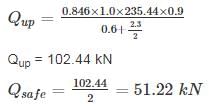

If the rectangular footing is loaded with eccentric loads having an eccentricity (ex) and (ey) as shown in the figure below, then the effective area taken to calculate the ultimate bearing capacity of soil will be ______ m2
Correct answer is between '3.6,3.7'. Can you explain this answer?
If the rectangular footing is loaded with eccentric loads having an eccentricity (ex) and (ey) as shown in the figure below, then the effective area taken to calculate the ultimate bearing capacity of soil will be ______ m2

|
Nayanika Joshi answered |
For eccentric condition, effective area is taken to be
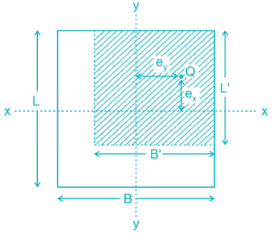
Effective area (A') = L' × B'
L' = L – 2ex
B' = B – 2ey
A' = L' × B'
L' = L – 2ex
L' = 3 – 2 × 0.2
L' = 2.6 m
B' = B – 2ey
B' = 2 – 2 × 0.3
B' = 1.4 m
A' = 2.6 × 1.4
A' = 3.64 m2
The term ‘Loess’ indicates those soils which are1. Uniformly graded2. Poorly graded3. Made up of more than 50% sand size particles4. Made up of more than 50% of silt particles5. These are transported by windsWhich of the above statements are correct:- a)2,3 & 5
- b)1,4 & 5
- c)2 & 4
- d)1 & 3
Correct answer is option 'B'. Can you explain this answer?
The term ‘Loess’ indicates those soils which are
1. Uniformly graded
2. Poorly graded
3. Made up of more than 50% sand size particles
4. Made up of more than 50% of silt particles
5. These are transported by winds
Which of the above statements are correct:
a)
2,3 & 5
b)
1,4 & 5
c)
2 & 4
d)
1 & 3

|
Kavya Mehta answered |
Loess is an Aeolian Sediment i.e. transported by winds.
These contain fine particles like silt and clay (typically in the 20–50 micrometer size range).
Loess is uniformly graded soil.
It is usually homogeneous and highly porous and is traversed by vertical capillaries that permit the sediment to fracture and form vertical bluffs.
Choose the correct statement1. Soils with small volume changes are compacted to the dry side of optimum.2. Soils with large volume changes are compacted to the wet side of optimum.- a)Both 1 and 2
- b)Only 1
- c)Only 2
- d)None of these
Correct answer is option 'A'. Can you explain this answer?
Choose the correct statement
1. Soils with small volume changes are compacted to the dry side of optimum.
2. Soils with large volume changes are compacted to the wet side of optimum.
a)
Both 1 and 2
b)
Only 1
c)
Only 2
d)
None of these

|
Deepika Saha answered |
Understanding Soil Compaction
Soil compaction is a critical process in civil engineering, particularly for enhancing the stability and load-bearing capacity of soil. The statements in the question relate to how different soils behave during compaction based on their volume change characteristics.
Soils with Small Volume Changes
- These soils tend to have low plasticity and minimal expansion or shrinkage when moisture content changes.
- When compacted to the dry side of optimum, these soils achieve higher density and strength.
- This approach reduces the risk of future settlement or structural issues as they are less susceptible to moisture fluctuations.
Soils with Large Volume Changes
- These soils often have high plasticity and are prone to significant volume changes with moisture content variations.
- Compacted to the wet side of optimum, these soils achieve maximum density while minimizing the risk of swelling or shrinkage.
- This compaction strategy helps manage moisture more effectively, reducing the potential for future instability.
Conclusion
Both statements are correct:
- Soils with small volume changes are indeed compacted to the dry side of optimum for stability.
- Conversely, soils with large volume changes benefit from being compacted to the wet side of optimum to control their expansive tendencies.
Thus, the correct answer is option 'A': Both 1 and 2. Understanding these principles is vital for effective soil management and ensuring structural integrity in civil engineering projects.
Soil compaction is a critical process in civil engineering, particularly for enhancing the stability and load-bearing capacity of soil. The statements in the question relate to how different soils behave during compaction based on their volume change characteristics.
Soils with Small Volume Changes
- These soils tend to have low plasticity and minimal expansion or shrinkage when moisture content changes.
- When compacted to the dry side of optimum, these soils achieve higher density and strength.
- This approach reduces the risk of future settlement or structural issues as they are less susceptible to moisture fluctuations.
Soils with Large Volume Changes
- These soils often have high plasticity and are prone to significant volume changes with moisture content variations.
- Compacted to the wet side of optimum, these soils achieve maximum density while minimizing the risk of swelling or shrinkage.
- This compaction strategy helps manage moisture more effectively, reducing the potential for future instability.
Conclusion
Both statements are correct:
- Soils with small volume changes are indeed compacted to the dry side of optimum for stability.
- Conversely, soils with large volume changes benefit from being compacted to the wet side of optimum to control their expansive tendencies.
Thus, the correct answer is option 'A': Both 1 and 2. Understanding these principles is vital for effective soil management and ensuring structural integrity in civil engineering projects.
The laboratory test results of the soil sample are given below:Liquid limit = 37%Plastic limit = 22%% passing through 75 μ sieve = 26%% retained over 4.75 mm IS sieve = 65%% retained over 0.075 mm but passing through 4.75 mm = 26%As per IS 1498 – 1970, the soil is classified as:- a)GC
- b)SC
- c)CI
- d)GM
Correct answer is option 'A'. Can you explain this answer?
The laboratory test results of the soil sample are given below:
Liquid limit = 37%
Plastic limit = 22%
% passing through 75 μ sieve = 26%
% retained over 4.75 mm IS sieve = 65%
% retained over 0.075 mm but passing through 4.75 mm = 26%
As per IS 1498 – 1970, the soil is classified as:
a)
GC
b)
SC
c)
CI
d)
GM

|
Partho Jain answered |
% passing through 75 μ sieve = 26%
% retained over 75 μ sieve = 100 – 26% = 74 % > 50%
Hence the soil is coarse grained soil.
As, larger proportion of soil is retained over 4.75 mm IS sieve, so the soil is termed as Gravel.
Now, % fineness = 26% > 12%
So, use Ip to further classify the soil
IP = wL - wP = 37 – 22 = 15%
IP = 15% > 7%
So, soil is termed as clayey Gravel.
A lake of depth 15 m is filled with water up to a depth of 10 m from the Bottom of the lake. Soft clay is present below the bottom of the lake up to a certain depth of more than 20 m. Submerged unit weight of the clay is given as 9.5 kN/m3. Take γw = 10 kN/m3. Calculate the effective Stress (kN/m2) at a depth of 15 m below the bottom of the lake.
Correct answer is between '142,143'. Can you explain this answer?
A lake of depth 15 m is filled with water up to a depth of 10 m from the Bottom of the lake. Soft clay is present below the bottom of the lake up to a certain depth of more than 20 m. Submerged unit weight of the clay is given as 9.5 kN/m3. Take γw = 10 kN/m3. Calculate the effective Stress (kN/m2) at a depth of 15 m below the bottom of the lake.

|
Anshu Kumar answered |
Understanding Effective Stress
Effective stress is crucial in soil mechanics, representing the stress carried by the soil skeleton. It is calculated using the formula:
Effective Stress = Total Stress - Pore Water Pressure
Calculation Steps
1. Determine Total Stress at 15 m Depth
- The total depth of 15 m is measured from the bottom of the lake, which means we need to consider the water depth and the depth of the clay below.
- The water column exerts pressure calculated as:
Total Stress (σ) = (Depth of water) * γw
= 10 m * 10 kN/m³ = 100 kN/m²
2. Depth of Clay Below the Lake
- The clay extends beyond the lake's bottom, reaching at least 20 m depth, totaling 15 m depth from the lake's bottom down to the clay.
- Therefore, we consider the pressure due to the clay weight as well:
Total Stress from clay (σ_clay) = (Depth of clay) * γ_clay
= 15 m * 9.5 kN/m³ = 142.5 kN/m²
3. Calculate Total Stress
- Combine both contributions:
Total Stress = σ + σ_clay
= 100 kN/m² + 142.5 kN/m² = 242.5 kN/m²
4. Calculate Pore Water Pressure
- The pore water pressure at this depth is calculated using the submerged unit weight of the clay:
Pore Water Pressure (u) = Depth * γw
= 15 m * 10 kN/m³ = 150 kN/m²
5. Calculate Effective Stress
- Finally, use the effective stress formula:
Effective Stress (σ') = Total Stress - Pore Water Pressure
= 242.5 kN/m² - 150 kN/m² = 92.5 kN/m²
Conclusion
The effective stress at a depth of 15 m below the lake is approximately 92.5 kN/m² and does not align with the expected range of 142-143 kN/m². Thus, ensure to verify the depth and unit weights are accurately represented for precise calculations.
Effective stress is crucial in soil mechanics, representing the stress carried by the soil skeleton. It is calculated using the formula:
Effective Stress = Total Stress - Pore Water Pressure
Calculation Steps
1. Determine Total Stress at 15 m Depth
- The total depth of 15 m is measured from the bottom of the lake, which means we need to consider the water depth and the depth of the clay below.
- The water column exerts pressure calculated as:
Total Stress (σ) = (Depth of water) * γw
= 10 m * 10 kN/m³ = 100 kN/m²
2. Depth of Clay Below the Lake
- The clay extends beyond the lake's bottom, reaching at least 20 m depth, totaling 15 m depth from the lake's bottom down to the clay.
- Therefore, we consider the pressure due to the clay weight as well:
Total Stress from clay (σ_clay) = (Depth of clay) * γ_clay
= 15 m * 9.5 kN/m³ = 142.5 kN/m²
3. Calculate Total Stress
- Combine both contributions:
Total Stress = σ + σ_clay
= 100 kN/m² + 142.5 kN/m² = 242.5 kN/m²
4. Calculate Pore Water Pressure
- The pore water pressure at this depth is calculated using the submerged unit weight of the clay:
Pore Water Pressure (u) = Depth * γw
= 15 m * 10 kN/m³ = 150 kN/m²
5. Calculate Effective Stress
- Finally, use the effective stress formula:
Effective Stress (σ') = Total Stress - Pore Water Pressure
= 242.5 kN/m² - 150 kN/m² = 92.5 kN/m²
Conclusion
The effective stress at a depth of 15 m below the lake is approximately 92.5 kN/m² and does not align with the expected range of 142-143 kN/m². Thus, ensure to verify the depth and unit weights are accurately represented for precise calculations.
Which one of the following is correct in respect of pore water pressure u and effective stress σ, in the soil just below the bottom of a pond due to a 2 m rise in water level in the pond?- a)u increases by 20 kN/m2 and σ remains unaltered
- b)u increases by 20 kN/m2 and σ decreases by 20 kN/m2.
- c)u decreases by 20 kN/m2 and σ remains unaltered
- d)Both u and σ remain unaltered
Correct answer is option 'A'. Can you explain this answer?
Which one of the following is correct in respect of pore water pressure u and effective stress σ, in the soil just below the bottom of a pond due to a 2 m rise in water level in the pond?
a)
u increases by 20 kN/m2 and σ remains unaltered
b)
u increases by 20 kN/m2 and σ decreases by 20 kN/m2.
c)
u decreases by 20 kN/m2 and σ remains unaltered
d)
Both u and σ remain unaltered

|
Sanaya Sengupta answered |
A) u and effective stress are independent of each other.
This statement is incorrect. Pore water pressure and effective stress are interdependent. Pore water pressure affects the effective stress of soil and vice versa. An increase in pore water pressure reduces the effective stress and can lead to soil liquefaction or slope instability. On the other hand, a decrease in pore water pressure increases the effective stress and can lead to soil consolidation. Therefore, u and effective stress are not independent of each other.
This statement is incorrect. Pore water pressure and effective stress are interdependent. Pore water pressure affects the effective stress of soil and vice versa. An increase in pore water pressure reduces the effective stress and can lead to soil liquefaction or slope instability. On the other hand, a decrease in pore water pressure increases the effective stress and can lead to soil consolidation. Therefore, u and effective stress are not independent of each other.
The yield of a well depends upon:- a)Permeability of soil
- b)Area of aquifer opening into the wells
- c)Actual flow velocity
- d)all of the above
Correct answer is option 'D'. Can you explain this answer?
The yield of a well depends upon:
a)
Permeability of soil
b)
Area of aquifer opening into the wells
c)
Actual flow velocity
d)
all of the above

|
Puja Sharma answered |
Yield of well means the discharge from the well excavated through given aquifer
Q = nva A = KiA
where
n is porosity
va is actual flow velocity of ground water
A is area of the aquifer opening onto the wells
K is permeability of soil
The following data are given for soil:• Porosity: n = 0.4• The specific gravity of the soil solids: Gs = 2.68• Moisture content: w = 12%Determine the mass of water in kg to be added to 10 m3 of soil for full saturation.
Correct answer is between '2065,2077'. Can you explain this answer?
The following data are given for soil:
• Porosity: n = 0.4
• The specific gravity of the soil solids: Gs = 2.68
• Moisture content: w = 12%
Determine the mass of water in kg to be added to 10 m3 of soil for full saturation.

|
Garima Kulkarni answered |

Total volume of soil, V = 10 m3
∴ VV = 0.4 × 10 = 4m3
Volume of solids, Vs = V – VV = 10 – 4 = 6 m3


Mass of solids, Ws = Vs Gs Yw = 6 × 2.68 × 1000 = 16080 kg
Moisture content = 0.12
So, Mass of water = 0.12 × 16080 = 1929.6 kg
Volume of water = 1929.6/1000 = 1.929 m3
So, phase diagram can be shown as
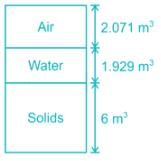

For full saturation, the amount of air has to be replaced by water.
So, water to be added = 2.071 × 1000 = 2071 kg
Consider the following statements regarding clay particles.1. The clay particles carry a net negative charge.2. The cation concentration increases with the distance from the surface of the particle.3. When the spacing between the two clay particles is very small, the force of attraction is greater than the force of repulsion.The correct statements are:- a)1 and 2 only
- b)2 and 3 only
- c)1 and 3 only
- d)1, 2 and 3
Correct answer is option 'C'. Can you explain this answer?
Consider the following statements regarding clay particles.
1. The clay particles carry a net negative charge.
2. The cation concentration increases with the distance from the surface of the particle.
3. When the spacing between the two clay particles is very small, the force of attraction is greater than the force of repulsion.
The correct statements are:
a)
1 and 2 only
b)
2 and 3 only
c)
1 and 3 only
d)
1, 2 and 3

|
Bhaskar Joshi answered |
1. Net Negative Charge:
- Clay particles carry a net negative charge due to isomorphic substitution of cations by anions in their crystal lattice. This negative charge leads to the adsorption of cations on the surface of the clay particles.
2. Cation Concentration Gradient:
- The cation concentration increases with the distance from the surface of the clay particle. This is known as the diffuse double layer phenomenon, where cations form a layer around the clay particle due to electrostatic forces.
3. Force of Attraction vs. Repulsion:
- When the spacing between two clay particles is very small, the force of attraction between them is greater than the force of repulsion. This is because the cations in the diffuse double layer of one particle are attracted to the negatively charged surface of the other particle, leading to flocculation.
Therefore, the correct statements are 1 and 3 only. Clay particles carry a net negative charge and when the spacing between particles is small, the force of attraction is greater than the force of repulsion due to cation bridging.
- Clay particles carry a net negative charge due to isomorphic substitution of cations by anions in their crystal lattice. This negative charge leads to the adsorption of cations on the surface of the clay particles.
2. Cation Concentration Gradient:
- The cation concentration increases with the distance from the surface of the clay particle. This is known as the diffuse double layer phenomenon, where cations form a layer around the clay particle due to electrostatic forces.
3. Force of Attraction vs. Repulsion:
- When the spacing between two clay particles is very small, the force of attraction between them is greater than the force of repulsion. This is because the cations in the diffuse double layer of one particle are attracted to the negatively charged surface of the other particle, leading to flocculation.
Therefore, the correct statements are 1 and 3 only. Clay particles carry a net negative charge and when the spacing between particles is small, the force of attraction is greater than the force of repulsion due to cation bridging.
A sample of dry sand was subjected to tri - axial test with a confining pressure of 250 kN/m2. The angle of internal friction is found to be 36°. The sample is likely to fail at deviator stress of ________ kN/m2.
Correct answer is between '712,714'. Can you explain this answer?
A sample of dry sand was subjected to tri - axial test with a confining pressure of 250 kN/m2. The angle of internal friction is found to be 36°. The sample is likely to fail at deviator stress of ________ kN/m2.

|
Avik Chaudhary answered |
Here, σ3 = 250 kN/m2
σ1 = σ3 + σd
Where, σd is the deviator stress
Using plastic equilibrium condition,

As sandy soil, C = 0


As sandy soil, C = 0

⇒ 250 + σd = 962.96
⇒ σd = 712.95 kN/m2
A multi-storied building is to be completed over a fine clayey soil within three months. In order to analyze the shear strength of the foundation soil which of the following shear strength test will be most suitable.- a)Consolidated Undrained Test (CU)
- b)Unconsolidated Undrained Test (UU)
- c)Consolidated Drained Test (CD)
- d)All are equally suitable
Correct answer is option 'B'. Can you explain this answer?
A multi-storied building is to be completed over a fine clayey soil within three months. In order to analyze the shear strength of the foundation soil which of the following shear strength test will be most suitable.
a)
Consolidated Undrained Test (CU)
b)
Unconsolidated Undrained Test (UU)
c)
Consolidated Drained Test (CD)
d)
All are equally suitable

|
Charvi Kaur answered |
The purpose of a UU test is to determine the undrained shear strength of a saturated soil. The UU test consists of applying a cell pressure to the soil sample without drainage of porewater followed by increments of axial stress. The cell pressure is kept constant and the test is completed very quickly because in neither of the two stages—consolidation and shearing—is the excess porewater pressure allowed to drain.
Suitability of UU test: When construction is very fast such as in case of foundation over fine clay.
Suitability of UU test: When construction is very fast such as in case of foundation over fine clay.
36 Piles are arranged in a square pattern which is embedded in the clayey soil. The shear strength at the base of the pile is 200 kN/m2 and the average shear strength over the depth of the pile is 130 kN/m2. If the Diameter and length of the pile are 0.4 m and 12 m respectively, the safe load that the pile group can carry will be _______ kN. Assume, centre to centre spacing between the pile = 0.8 m, Adhesion factor (α) = 0.50 and Factor of safety = 3
Correct answer is between '14474,14478'. Can you explain this answer?
36 Piles are arranged in a square pattern which is embedded in the clayey soil. The shear strength at the base of the pile is 200 kN/m2 and the average shear strength over the depth of the pile is 130 kN/m2. If the Diameter and length of the pile are 0.4 m and 12 m respectively, the safe load that the pile group can carry will be _______ kN. Assume, centre to centre spacing between the pile = 0.8 m, Adhesion factor (α) = 0.50 and Factor of safety = 3

|
Ishaan Kulkarni answered |
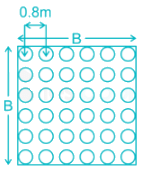
B = (n – 1)s + d
B = (6 – 1) × 0.8 + 0.4
B = 4.0 + 0.4 = 4.4 m
Ultimate load carrying capacity of single pile:
Qup = qb Ab + qs As
Qb = base resistance of pile = 9c
c = cohesion at base of the pile

ϕ = 0° (clay)
Sbase = c = 200 kN/m2
qs = average skin friction resistance


Qup = 1206.37 kN
Ultimate load carrying capacity of pile group


= 9 × 200 × (4.4)2 + 0.5 × 130 × 4 × 4.4 × 12
Qug = 48576 kN
Safe load on pile group = 
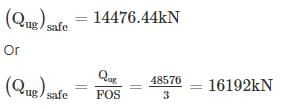
So, safe load on pile group will be lesser of two. Hence safe load = 14476.44 kN


So, safe load on pile group will be lesser of two. Hence safe load = 14476.44 kN
A rectangular footing is located at a depth of 1.5 m below the ground surface. It is required to carry the safe load of 1200 kN at the base of the footing. Calculate the area of the footing at the base in m2. Take factor of safety of 2.5 and bearing capacity factors as NC = 38, Nq = 23 and Nγ = 21. Assume water table at a great depth. Use Terzaghi’s ultimate bearing capacity equation. Assume the length to width ratio of the footing to be 1.5. Cohesion c = 100 kN/m2 and unit weight of soil to be 19 kN/m3.
Correct answer is between '0.55,0.58'. Can you explain this answer?
A rectangular footing is located at a depth of 1.5 m below the ground surface. It is required to carry the safe load of 1200 kN at the base of the footing. Calculate the area of the footing at the base in m2. Take factor of safety of 2.5 and bearing capacity factors as NC = 38, Nq = 23 and Nγ = 21. Assume water table at a great depth. Use Terzaghi’s ultimate bearing capacity equation. Assume the length to width ratio of the footing to be 1.5. Cohesion c = 100 kN/m2 and unit weight of soil to be 19 kN/m3.

|
Jhanvi Choudhary answered |
Concept:
Ultimate bearing capacity given by Terzaghi for rectangular footing is:

Where,
B = width of footing
L = Length of footing
c = Cohesion (kN/m2)
Nc, Nq, Nγ = Bearing capacity factors
γ = unit weight of the soil
Df = Depth of footing
Net ultimate Bearing capacity
qnu = qu - γDf
Net safe Bearing capacity




qu = 4560 + 655.5 + 172.9 B
qnu = 5215.5 + 172.9 B - γDf
qnu = 5215.5 + 172.9 B – 19 × 1.5
qnu = 5187 + 172.9 B
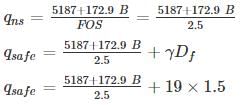
qsafe = 2074.8 + 69.16 B + 28.5

800 = (2103.3 + 69.16 B) B2

qsafe = 2074.8 + 69.16 B + 28.5

800 = (2103.3 + 69.16 B) B2
B = 0.61 m
L = 1.5 × 0.61 = 0.915 m
Area of footing = L x B = 0.558 m2
Consider the following statements. The incorrect statement is:- a)The water content has a range from 0% to 100%.
- b)The degree of saturation has ranged from 0% to 100%.
- c)The porosity cannot be greater than 100%.
- d)The void ratio of soil can be greater than 1.
Correct answer is option 'A'. Can you explain this answer?
Consider the following statements. The incorrect statement is:
a)
The water content has a range from 0% to 100%.
b)
The degree of saturation has ranged from 0% to 100%.
c)
The porosity cannot be greater than 100%.
d)
The void ratio of soil can be greater than 1.

|
Aditi Chakraborty answered |
Water content is the ratio of the mass of water to the mass of solids.
It can be greater than 100%.
The degree of saturation has ranged from 0% to 100%.
The porosity cannot be greater than 100%.
The void ratio of soil can be greater than 1.
According to Darcy’s law for flow through porous media, the velocity is proportional to- a)effective stress
- b)hydraulic gradient
- c)cohesion
- d)stability number
Correct answer is option 'B'. Can you explain this answer?
According to Darcy’s law for flow through porous media, the velocity is proportional to
a)
effective stress
b)
hydraulic gradient
c)
cohesion
d)
stability number

|
Mira Mishra answered |
Darcy established that the flow occurring per unit time is directly proportional to the head causing flow and the area of cross – section of the soil sample but is inversely proportional to the length of the soil sample

Dividing both sides by A

i.e., hydraulic gradient
A retaining wall of height H with smooth vertical backface supports a backfill inclined at an angle β with the horizontal. The backfill consists of cohesionless soil having an angle of internal friction ϕ. If the active lateral thrust acting on the wall is Pa, which one of the following statements is TRUE?- a)Pa acts at a height H/3 from the base of the wall and at an angle β with the horizontal
- b)Pa acts at a height H/3 from the base of the wall and at an angle ϕ with the horizontal
- c)Pa acts at a height H/2 from the base of the wall and at an angle β with the horizontal
- d)Pa acts at a height H/2 from the base of the wall and at an angle ϕ with the horizontal
Correct answer is option 'A'. Can you explain this answer?
A retaining wall of height H with smooth vertical backface supports a backfill inclined at an angle β with the horizontal. The backfill consists of cohesionless soil having an angle of internal friction ϕ. If the active lateral thrust acting on the wall is Pa, which one of the following statements is TRUE?
a)
Pa acts at a height H/3 from the base of the wall and at an angle β with the horizontal
b)
Pa acts at a height H/3 from the base of the wall and at an angle ϕ with the horizontal
c)
Pa acts at a height H/2 from the base of the wall and at an angle β with the horizontal
d)
Pa acts at a height H/2 from the base of the wall and at an angle ϕ with the horizontal

|
Bhaskar Rane answered |

For the retaining with supporting backfill of cohesionless soil having an angle of internal friction ϕ and inclined at an angle β with the horizontal. Active Earth Pressure (Pa) acts at a height H/3 from the base of the wall and at an angle β with the horizontal
15 metres of thick saturated clay is underlain by the sand layer and the sand layer is under artesian pressure equivalent to 5 metres head of water. Excavation is started and is it done up to 12.7 metres of depth in the clay layer at which the bottom heaves. For this much excavation depth in the clay. How much-saturated unit weight of clay you expect such that bottom will not heaves?- a)less than 11.33 kN/m3
- b)greater than 11.33 kN/m3
- c)less than 21.33 kN/m3
- d)greater than 21.33 kN/m3
Correct answer is option 'D'. Can you explain this answer?
15 metres of thick saturated clay is underlain by the sand layer and the sand layer is under artesian pressure equivalent to 5 metres head of water. Excavation is started and is it done up to 12.7 metres of depth in the clay layer at which the bottom heaves. For this much excavation depth in the clay. How much-saturated unit weight of clay you expect such that bottom will not heaves?
a)
less than 11.33 kN/m3
b)
greater than 11.33 kN/m3
c)
less than 21.33 kN/m3
d)
greater than 21.33 kN/m3

|
Dipanjan Ghosh answered |
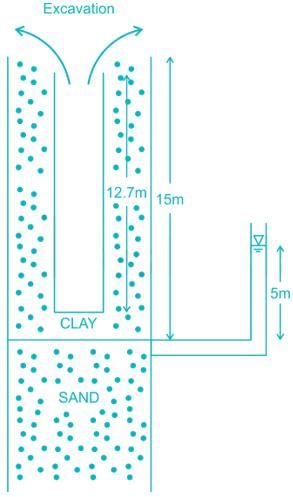
At C - C
∑ FB = 0
(15 - 12.70) × γsat - 5 × 9.81 = 0
γsat = 21.33 kN/m3
Which of the followings soil sample may be used to determine consistency limit of the soil?- a)Undisturbed samples
- b)Non – Representative sample
- c)Representative Sample
- d)Either of a) and c)
Correct answer is option 'D'. Can you explain this answer?
Which of the followings soil sample may be used to determine consistency limit of the soil?
a)
Undisturbed samples
b)
Non – Representative sample
c)
Representative Sample
d)
Either of a) and c)

|
Gowri Singh answered |
Undisturbed samples → if soil structure, mineral content and moisture content of the soil remains unchanged while sampling then it is called Undisturbed sample.
Representative sample → If soil structure is modified but mineral content and water, content remains unchanged while sampling then it is called representative sample.
Non – Representative Sample → If soil structure mineral content and water content all get modified then it is called non – representative sample.
To determine K, C, ϕ, Cc, Mv undisturbed sample should be used.
To determine consistency limit, specific gravity, particle size analysis either undisturbed or representative sample may be used.
To achieve 80% consolidation in a clay layer, the time required will be 15 years. If the clay layer is twice as thick, 15 times more permeable and 10 times less compressible, then the time that would be required to achieve the same degree of consolidation will be- a)2.4 months
- b)4.8 months
- c)48 months
- d)24 months
Correct answer is option 'B'. Can you explain this answer?
To achieve 80% consolidation in a clay layer, the time required will be 15 years. If the clay layer is twice as thick, 15 times more permeable and 10 times less compressible, then the time that would be required to achieve the same degree of consolidation will be
a)
2.4 months
b)
4.8 months
c)
48 months
d)
24 months

|
Sagnik Sen answered |
Concept:
Using the relation,
Time factor (TV) is given by


Where t = time required to consolidate the clay layer by (U%).
d = thickness of clay layer
cv = coefficient of consolidation
Also,
K = cv mv γw
Where,
K = permeability of soil sample
cv = coefficient of consolidation
mv = coefficient of volume compressibility
Calculation:
For U = 80%,
TV = TV1 and time required will be 15 years.

Now for same U, TV = TV2 = TV1 but d2 = 2d1, k2 = 15k1, mv2 = 110mv1
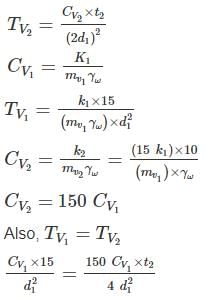
TV = TV1 and time required will be 15 years.

Now for same U, TV = TV2 = TV1 but d2 = 2d1, k2 = 15k1, mv2 = 110mv1

t2 = 0.4 years
t2 = 4.8 months
A 5m high vertical earth retaining wall having smooth vertical back retains non-cohesive soil with angle of internal friction 35° and unit weight γ = 18 kN/m3. If the wall is free to field and the water table is at a depth of 2m below the top of the wall, then the total horizontal active thrust (kN) per unit length acting on the wall will beTake γsat = 20 kN/m3, γω = 10kN/m3.- a)96.221 kN/m
- b)86.46 kN/m
- c)108.416 kN/m
- d)120 kN/m
Correct answer is option 'A'. Can you explain this answer?
A 5m high vertical earth retaining wall having smooth vertical back retains non-cohesive soil with angle of internal friction 35° and unit weight γ = 18 kN/m3. If the wall is free to field and the water table is at a depth of 2m below the top of the wall, then the total horizontal active thrust (kN) per unit length acting on the wall will be
Take γsat = 20 kN/m3, γω = 10kN/m3.
a)
96.221 kN/m
b)
86.46 kN/m
c)
108.416 kN/m
d)
120 kN/m

|
Asha Deshpande answered |

Total active earth pressure at 2m below the Ground level = kaγ×2

Active thrust:
Pa1 = 12 × ka × γ × 2 × 2 =

Pa1 = 9.756 kN/m
Total active earth pressure at 5m below the Ground level:
= ka × γ ×2 + kaγ1×3 + γω × 3
= 0.271 × 18 × 2 + 0.271 × [20 – 10] × 3 + 10 × 3
= 47.88 kN/m2
Active thrust:-

Pa = 9.756 + 29.27 + 12.195 + 45
Active thrust:-

Pa = 9.756 + 29.27 + 12.195 + 45
Pa = 96.221 kN/m
A soil mass contains 40 % gravel, 50 % sand 10 % silt. The soil can be classified as-- a)Silty Sandy gravel having Cu<60
- b)Silty Gravely Sand having Cu = 10
- c)Silty Gravely sand having Cu> 60
- d)Gravelly Silty Sand - Cu can’t be calculated
Correct answer is option 'C'. Can you explain this answer?
A soil mass contains 40 % gravel, 50 % sand 10 % silt. The soil can be classified as-
a)
Silty Sandy gravel having Cu<60
b)
Silty Gravely Sand having Cu = 10
c)
Silty Gravely sand having Cu> 60
d)
Gravelly Silty Sand - Cu can’t be calculated

|
Naina Das answered |

D60 = 4.75 mm and D10 = 0.075mm
Implies Cu = D60/ D10 = 4.75/0.075 = 63.33
In an Octahedral unit if Fe2+ is present at the center of the geometry, what will be the net charge present over this unit.- a)-1
- b)0
- c)+1
- d)-2
Correct answer is option 'B'. Can you explain this answer?
In an Octahedral unit if Fe2+ is present at the center of the geometry, what will be the net charge present over this unit.
a)
-1
b)
0
c)
+1
d)
-2

|
Partho Jain answered |
In Octahedral unit 6 Hydroxyl atoms encloses Fe2+ (as in this case) at the centre of Octahedral Geometry where in each hydroxyl atom is shared in between 3 Octahedral units.Net charge present = − 6 × 1/3 + 2 = 0
A water tank is supported on 4 columns, which form a square of side 3m. The total load of the water tank is 400 ton. Assuming the load on each footing as point load, find the vertical stress induced at a depth of 3m under any one of the footings? (In t/m2)
Correct answer is between '7.5,7.6'. Can you explain this answer?
A water tank is supported on 4 columns, which form a square of side 3m. The total load of the water tank is 400 ton. Assuming the load on each footing as point load, find the vertical stress induced at a depth of 3m under any one of the footings? (In t/m2)

|
Uday Kumar answered |
The arrangement of the column / footing will be as follows:
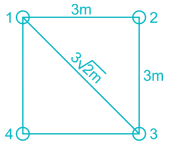
Total load = 400 ton.
load in each column, Q = 400/4 = 100 ton
∴ Stress at a depth of 3m under any column

Total load = 400 ton.
load in each column, Q = 400/4 = 100 ton
∴ Stress at a depth of 3m under any column
(Two column will be at a distance 3 m & one column will be at a distance 3√2m)
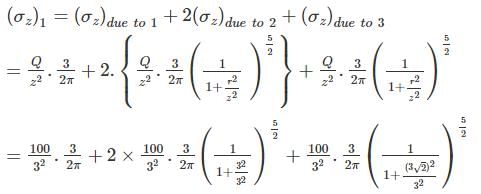

= 5.30+ 1.876+ 0.34
= 7.516 ton/m2
A sampling tube has an inner diameter and outside diameter as shown in the figure below.D1 = 75 mmD2 = 80 mmD3 = 77 mmD4 = 78 mmThe inside clearance (%) of the samples is- a)2.67%
- b)1.30%
- c)13.78%
- d)2.56%
Correct answer is option 'A'. Can you explain this answer?
A sampling tube has an inner diameter and outside diameter as shown in the figure below.
D1 = 75 mm
D2 = 80 mm
D3 = 77 mm
D4 = 78 mm
The inside clearance (%) of the samples is
a)
2.67%
b)
1.30%
c)
13.78%
d)
2.56%

|
Ashwin Desai answered |
Concept:
% inside clearance = 

where D3 = Inside diameter of sampling tube
D1 = Inside diameter of cutting edge shoe
Calculation:

Ci = 2.67%
It must lies between 1 to 3%
Consider the following statements:P. For a clay layer, the net ultimate bearing capacity (By Skempton) at the base of the footing is independent of the cohesion of the soil.Q. If the depth of the strip footing is equal to the width of the footing, then the value of bearing capacity factor (Nc) by skempton is taken to be 6.0.R. The theory given by Skempton for net ultimate bearing capacity computations is valid for shallow footings only.S. Local shear failure occurs in soft clays and loose sands.Identify the correct option:- a)P-False, Q-True, R-True, S-False
- b)P-True, Q-False, R-False, S-True
- c)P-True, Q-False, R-True, S-False
- d)P-False, Q-True, R-False, S-True
Correct answer is option 'D'. Can you explain this answer?
Consider the following statements:
P. For a clay layer, the net ultimate bearing capacity (By Skempton) at the base of the footing is independent of the cohesion of the soil.
Q. If the depth of the strip footing is equal to the width of the footing, then the value of bearing capacity factor (Nc) by skempton is taken to be 6.0.
R. The theory given by Skempton for net ultimate bearing capacity computations is valid for shallow footings only.
S. Local shear failure occurs in soft clays and loose sands.
Identify the correct option:
a)
P-False, Q-True, R-True, S-False
b)
P-True, Q-False, R-False, S-True
c)
P-True, Q-False, R-True, S-False
d)
P-False, Q-True, R-False, S-True

|
Aniket Ghoshal answered |
SKEMPTON’S Method:
This theory is applicable only for C-soils but it can be applied for shallow and deep footings both. In this theory, base resistance and side resistance both are considered. The net ultimate bearing capacity is given by:
qnu=CNc
Where,
Nc = Skempton’s bearing capacity factor which depends upon Df/B ratio
Hence for a clay layer, the net ultimate bearing capacity (By Skempton) at the base of the footing is directly proportional to the cohesion of the soil.
Case 1: When Df/B = 0,
Nc = 5.0 (strip footing)
= 6.0 (Square/Circular/Rectangular/ Raft)
Case 2: When 0 Df/B < 2.5

Case 3: When
Case 2: When 0 Df/B < 2.5

Case 3: When

Nc = 7.5 (Strip footing)
Nc = 9.0 (Square/circular/rectangular/raft)
Therefore, when B = Df , case 2 is valid


Local shear failure:
This type of failure is seen in relatively loose sand and soft clay.
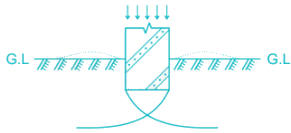

Some characteristics of local shear failure are:
1. Failure is not sudden and there is no tilting of footing.
2. Failure surface does not reach the ground surface and slight bulging of soil around the footing is observed
3. Failure surface is not well defined
4. Failure is progressive
5. In load-settlement curve, there is no well-defined peak
6. Failure is characterized by considerable settlement directly beneath the foundation
7. A significant compression of soil below the footing and partial development of plastic equilibrium is observed.
8. Well-defined wedge and slip surfaces only beneath the foundation.
Choose the incorrect statement:1) Greater the confining pressure, smaller the critical void ratio.2) A saturated loose sand is likely to liquify when subjected to earthquake shocks.3) Failure envelope of over consolidated clay is a curve and not straight line.4) For normally consolidated clays, ϕ decrease with an increase in plasticity.- a)1 and 2
- b)3 only
- c)4 only
- d)None of these
Correct answer is option 'D'. Can you explain this answer?
Choose the incorrect statement:
1) Greater the confining pressure, smaller the critical void ratio.
2) A saturated loose sand is likely to liquify when subjected to earthquake shocks.
3) Failure envelope of over consolidated clay is a curve and not straight line.
4) For normally consolidated clays, ϕ decrease with an increase in plasticity.
a)
1 and 2
b)
3 only
c)
4 only
d)
None of these

|
Ishani Chauhan answered |
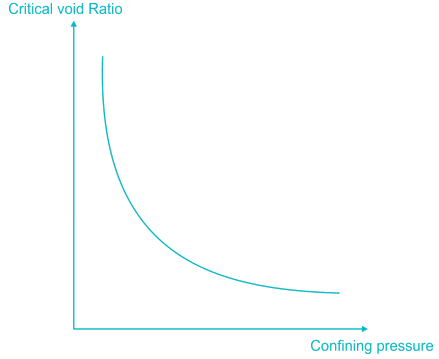
The relationship between critical void ratio and confining pressure is shown in figure. As confining pressure increases, the critical void ratio decreases. With this knowledge of relationship it is possible predict the behaviour of sand at any ratio and at any given confining pressure.
All other statements are also true.
Chapter doubts & questions for Soil Mechanics - RRB JE for Civil Engineering 2025 is part of Civil Engineering (CE) exam preparation. The chapters have been prepared according to the Civil Engineering (CE) exam syllabus. The Chapter doubts & questions, notes, tests & MCQs are made for Civil Engineering (CE) 2025 Exam. Find important definitions, questions, notes, meanings, examples, exercises, MCQs and online tests here.
Chapter doubts & questions of Soil Mechanics - RRB JE for Civil Engineering in English & Hindi are available as part of Civil Engineering (CE) exam.
Download more important topics, notes, lectures and mock test series for Civil Engineering (CE) Exam by signing up for free.
RRB JE for Civil Engineering
2 docs|42 tests
|

Contact Support
Our team is online on weekdays between 10 AM - 7 PM
Typical reply within 3 hours
|
Free Exam Preparation
at your Fingertips!
Access Free Study Material - Test Series, Structured Courses, Free Videos & Study Notes and Prepare for Your Exam With Ease

 Join the 10M+ students on EduRev
Join the 10M+ students on EduRev
|

|
Create your account for free
OR
Forgot Password
OR
Signup to see your scores
go up within 7 days!
Access 1000+ FREE Docs, Videos and Tests
Takes less than 10 seconds to signup

